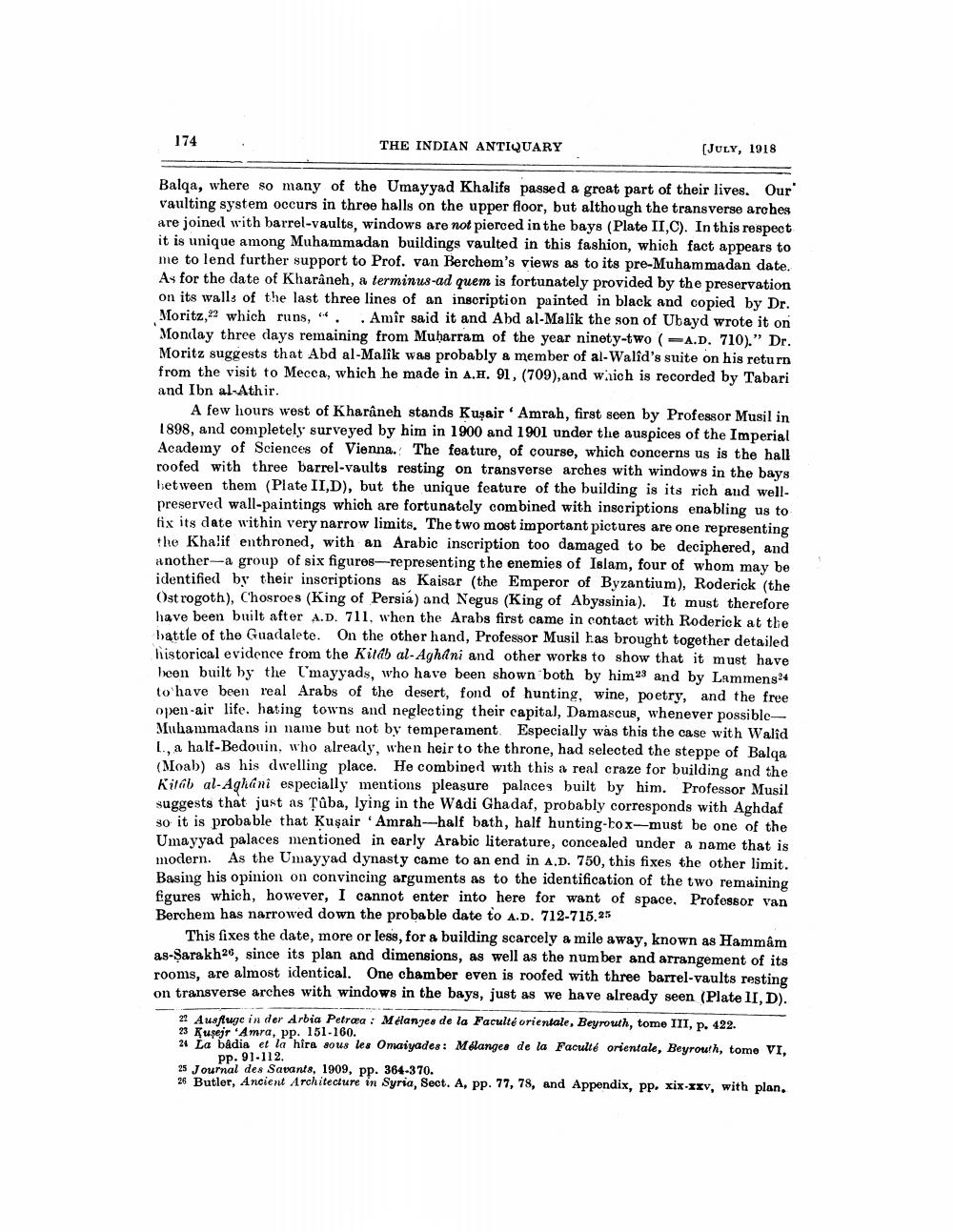________________
174
THE INDIAN ANTIQUARY
(JULY, 1918
Balqa, where so many of the Umayyad Khalifs passed a great part of their lives. Our Vaulting system occurs in three halls on the upper floor, but although the transverse arches are joined with barrel-vaults, windows are not pierced in the bays (Plate II,C). In this respect it is unique among Muhammadan buildings vaulted in this fashion, which fact appears to me to lend further support to Prof. van Berchem's views as to its pre-Muhammadan date. As for the date of Kharaneh, a terminus-ad quem is fortunately provided by the preservation on its walls of the last three lines of an inscription painted in black and copied by Dr. Moritz,22 which runs, *. .Amîr said it and Abd al-Malik the son of Ubayd wrote it on Monday three days remaining from Muharram of the year ninety-two ( A.D. 710)." Dr. Moritz suggests that Abd al-Malik was probably a member of al-Walid's suite on his return from the visit to Mecca, which he made in A.H. 91, (709), and which is recorded by Tabari and Ibn al-Athir.
A few hours west of Kharâneh stands Kusair Amrah, first seen by Professor Musil in 1898, and completely surveyed by him in 1900 and 1901 under the auspices of the Imperial Academy of Sciences of Vienna. The feature, of course, which concerns us is the hall roofed with three barrel-vaults resting on transverse arches with windows in the bays between them (Plate II,D), but the unique feature of the building is its rich and wellpreserved wall-paintings which are fortunately combined with inscriptions enabling us to fix its date within very narrow limits. The two most important pictures are one representing the Khalif enthroned, with an Arabic inscription too damaged to be deciphered, and another-a group of six figures-representing the enemies of Islam, four of whom may be identified by their inscriptions as Kaisar (the Emperor of Byzantium), Roderick (the Ostrogoth), Chosroes (King of Persia) and Negus (King of Abyssinia). It must therefore have been built after A.D. 711, when the Arabs first came in contact with Roderick at the battle of the Guadalete. On the other hand, Professor Musil has brought together detailed historical evidence from the Kitdb al-Aghani and other works to show that it must have been built by the l'mayyads, who have been shown both by him23 and by Lammens24 to have been real Arabs of the desert, fond of hunting, wine, poetry, and the free open-air life. hating towns and neglecting their capital, Damascus, whenever possibleMuhammadans in name but not by temperament. Especially was this the case with Walid L, a half-Bedouin, who already, when heir to the throne, had selected the steppe of Balqa (Moab) as his dwelling place. He combined with this a real craze for building and the Kitab al-Aghani especially mentions pleasure palaces built by him. Professor Musil suggests that just as sûba, lying in the Wadi Ghadaf, probably corresponds with Aghdaf so it is probable that Kusair 'Amrah--half bath, half hunting-tox-must be one of the Umayyad palaces mentioned in early Arabic literature, concealed under a name that is modern. As the Umayyad dynasty came to an end in A.D. 750, this fixes the other limit. Basing his opinion on convincing arguments as to the identification of the two remaining Egures which, however, I cannot enter into here for want of space. Professor van Berchem has narrowed down the probable date to A.D. 712-715,25
This fixes the date, more or less, for a building scarcely a mile away, known as Hammam as-Sarakh26, since its plan and dimensions, as well as the number and arrangement of its rooms, are almost identical. One chamber even is roofed with three barrel-vaults resting on transverse arches with windows in the bays, just as we have already seen (Plate II, D).
22 Ausfluje in der Arbia Petræa : Mélanges de la Faculté orientale, Beyrouth, tome III, p. 422. 23 Kusejr Amra, pp. 151-160. 24 La badia et la hira sous les Omaiyades: Mélanges de la Faculté orientale, Beyrouth, tome VI,
pp. 91-112. 25 Journal des Savants, 1909, pp. 364-370. 26 Butler, Ancient Architecture in Syria, Sect. A, pp. 77, 78, and Appendix, pp. xix-xxv, with plan.




